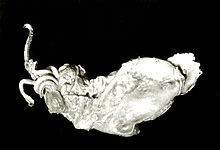Megalocranchia
| Megalocranchia | |
|---|---|

| |
| Megalocranchia fisheri | |
| Scientific classification | |
| Domain: | Eukaryota |
| Kingdom: | Animalia |
| Phylum: | Mollusca |
| Class: | Cephalopoda |
| Order: | Oegopsida |
| Family: | Cranchiidae |
| Subfamily: | Taoniinae |
| Genus: | Megalocranchia Pfeffer, 1884[1] |
| Type species | |
| Megalocranchia maxima Pfeffer, 1884 | |
| Species | |
|
Megalocranchia sp. A | |
Megalocranchia is a genus of glass squids. It occurs circumglobally in tropical and subtropical waters.[2]
Description
Some members of the genus Megalocranchia can reach large sizes, up to 1800mm in the case of M. fisheri. Young paralarvae often resemble other members of the Cranchiidae, having transparent bodies to aid in camouflage. Where the internal organs cannot be made transparent, for example in the digestive system, visceral photophores can be found. These visceral photophores are unique to this genus within the family. The paralarvae also have a thick gelatinous dermis covering the mantle, which again is unique to the Megalocranchia within the family. This dermis also features patches of orange chromatophores in juvenile individuals.
References
- ^ Julian Finn (2016). "Megalocranchia Pfeffer, 1884". World Register of Marine Species. Flanders Marine Institute. Retrieved 1 March 2018.
- ^ Voss N. A., S. J. Stephen & Zh. Dong 1992. Family Cranchiidae Prosch, 1849. Smithson. Contributions Zool. 513: 187-210.
- Giant squid found in Cayman head to US museum. Cayman News Service, 22 October 2013.
- Royal Caribbean helps transport giant squid to museum. Royal Caribbean Blog, 23 October 2013.
External links
